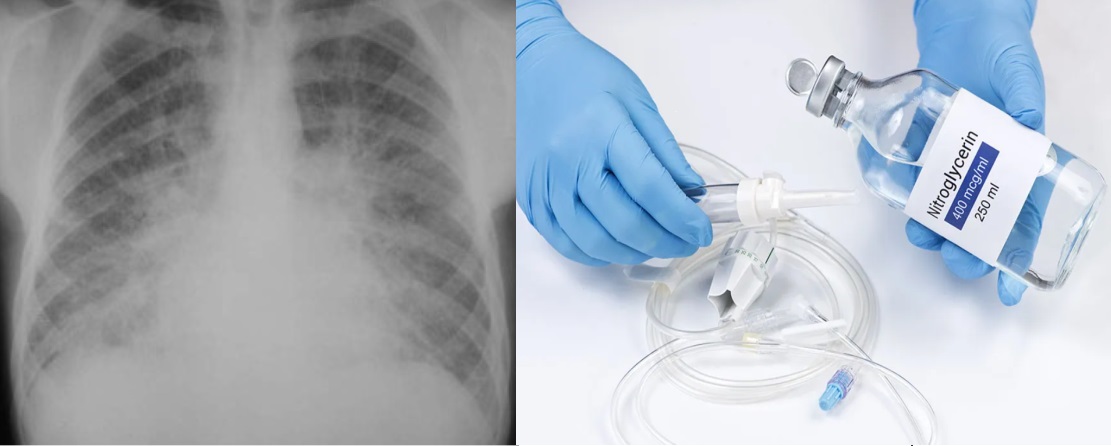

Case: A 75 yo F with a history of hypertension, diabetes and congestive heart failure comes in with acute shortness of breath which started in the past hour. On exam she is saturating 80% on room air and 88% on a non-rebreather. Her blood pressure is 180/100 and she is really working to breathe with significant indrawing and tachypnea. Her history is consistent with acute heart failure (aka flash pulmonary edema) and so you have called the respiratory therapist to initiate non invasive ventilation (NIV aka BiPAP/CPAP). While you are waiting, what is the first medication you should give?
- Furosemide (Lasix)
- Nitroglycerin Patch
- IV Nitroglycerin
- None of the above
Answer:
IV Nitroglycerin
IV Nitroglycerin should be the FIRST LINE medication in patients in acute heart failure (aka flash pulmonary edema) as long as they are not in shock (IE BP < 100).
Why?
These patients are usually in SCAPE – Sympathetic Crashing Acute Pulmonary Edema where there is a large sympathetic surge resulting in systemic vasoconstriction, pathologically elevated afterload and hypertension causing pulmonary congestion and dyspnea .
Ie- the sympathetic system is in overdrive causing the veins and arteries to constrict, forcing fluid into the lungs so the patient cannot breathe.
How does IV Nitroglycerin Help?
The high blood pressure causes the afterload to increase, causing fluid to build up in the lungs. So one of the top priorities, is to reduce the blood pressure/ afterload. Nitroglycerin reduces afterload and preload and redistributes fluid from the pulmonary system. It has actually been shown to decrease the need for intubation, ICU admission and faster resolution of symptoms.
But Doc, what about the Nitro Patch?
The nitro patch is USELESS in acute situations. Throw the patch out! The patch takes about 2 hours for full absorption and 1 patch is equivalent to max 13mcg/min
Ok, Got it. We give IV Nitro. That means we start at 10mcg/minute and titrate up right?
WRONG– You want to reduce the afterload and preload FAST. The faster you reduce it, the faster the patient improves.
If the blood pressure is greater than 140, then ideally you want to give about a 400-800ucg Bolus, and start a drip at around 150 ucg/min and titrate according to the blood pressure and symptom severity. It is better to start HIGH and titrate down. If blood pressure is still high, you can titrate upwards (Up to 300mcg/min, Some studies have shown patients receiving up to 800mcg/min for short durations). If the blood pressure is improving, you can titrate down
Note- If it is taking a while for the nurses to draw up or prepare the IV Nitroglycerin drip, then give 2 – 3 sprays of Nitroglycerin SL while waiting. 1 spray = 400 ucg
Whoa Doc. These doses are REALLY HIGH! Wont the patient become HYPOtensive?
Higher doses of Nitroglycerin are needed to achieve arterial vasodilation, compared to the doses given in angina, where the goal is veno-dilation. Also, these patients are profoundly vasoconstricted, so it takes a lot of afterload reduction for the BP to drop. In addition, IV nitroglycerin has a short half-life. Therefore, if the patient becomes hypotensive, you can either stop the IV nitro, or decrease it rapidly, and the patient’s blood pressure will improve in minutes.
IV Titration
Make sure that you are at bedside if IV Nitroglycerin drip concentration is above 150mcg. Just as quickly as SCAPE develops, it can resolve rapidly, so you want to decrease the infusion levels rapidly as well
But Doc, we heard that Lasix/ Furosemide is the best medication, and should be started RIGHT AWAY?
WRONG
Furosemide takes 1 hours to START working and max effect is within 1 – 2 hours. Therefore, it is NOT going to help in the ACUTE situation. Save your nursing resources! Start the IV nitro drip FIRST, THEN start furosemide.
Summary
- In the acute heart failure patient with HIGH blood pressure, first line medication is IV Nitroglycerin
- Start HIGH- Give a Bolus of 400mcg – 800mcg (up to 1200mcg) (Or 3 Nitroglycerin sprays SL) and start IV infusion at 150mcg
- Be at BEDSIDE if starting at high doses (> 150mcg) and titrate as per blood pressure
- Throw away the Nitro patch in acute situations
- Furosemide should be started AFTER the nitroglycerin. You have time
References/ Further Reading
- Hayes, B. D. (2021). High-dose nitroglycerin for sympathetic crashing acute pulmonary edema. ALiEM
- Farkas, J. (2022). Sympathetic crashing acute pulmonary edema (SCAPE). EMCrit Project
- Helman, A. (2022). Acute heart failure ED management. Emergency Medicine Cases
- McDonald, M., et al. (2021). CCS/CHFS heart failure guidelines update: Defining a new pharmacologic standard of care for heart failure with reduced ejection fraction. Canadian Journal of Cardiology, 37(4). Elsevier


Beth
April 13, 2024 at 8:02 amThis article is well organized and to the point. It helps reader to critically think and make connection to previous knowledge. Thank you for well written material. Keep the good work. 🙂